Volete spostare il vostro sito WordPress su un nuovo dominio?
La modifica del nome di dominio del vostro sito web può avere un impatto significativo sulle vostre classifiche SEO, quindi è un processo che deve essere eseguito con molta attenzione.
Sebbene non sia possibile evitare fluttuazioni temporanee della SEO quando si migra il sito web su un nuovo dominio, è possibile ridurre al minimo l’impatto e recuperare rapidamente il traffico di ricerca e le classifiche.
In questa guida vi mostreremo il modo corretto per spostare WordPress su un nuovo dominio senza perdere la SEO.
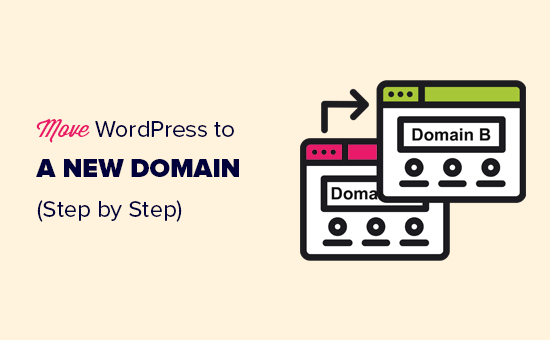
La migrazione del vostro sito WordPress a un nuovo nome di dominio può essere spaventosa, ma non deve esserlo per forza. Siamo qui per accompagnarvi in ogni fase del processo.
Potete fare clic su uno qualsiasi dei link sottostanti per passare a una fase specifica della migrazione del vostro sito WordPress a un nuovo nome di dominio:
- What to Know Before You Change Domains
- Pre-Steps: What You Need to Get Started
- Step 1: Create a Duplicator Package of Your WordPress Site
- Step 2: Create a Database for Your New Domain Name
- Step 3: Unpack WordPress on Your New Domain Name
- Step 4: Set Up Permanent 301 Redirects
- Step 5: Notify Google About Your New Domain
- Notify Your Users About the New Domain Name
Video tutorial
Se preferite le istruzioni scritte, continuate a leggere.
Cosa sapere prima di cambiare dominio
Prima di iniziare, ci sono alcune cose da sapere.
Il processo di trasferimento a un nuovo dominio influenzerà temporaneamente il posizionamento sui motori di ricerca, poiché Google e gli altri motori di ricerca dovranno adattarsi alle modifiche.
Sì, questo influirà temporaneamente anche sul vostro traffico di ricerca. Tenete presente che si tratta di una situazione normale, che capita a tutti i siti web che passano a un nuovo dominio.
Tuttavia, potete ridurre drasticamente l’impatto SEO seguendo questa guida. Vi mostreremo il modo giusto per spostare il vostro sito WordPress su un nuovo nome di dominio, impostare i reindirizzamenti 301 corretti e informare i motori di ricerca.
Si noti che questa guida non serve a spostare un sito WordPress su un nuovo host. Si tratta solo di cambiare un nome di dominio. Anche se il processo è simile, ci sono alcuni passaggi in più. Questi passaggi extra vi aiuteranno a proteggere le vostre classifiche SEO e il vostro traffico.
Infine, se il vostro vecchio sito è su WordPress.com, dovete seguire le istruzioni della nostra guida su come passare da WordPress.com a WordPress.org.
Passi preliminari: Cosa serve per iniziare
In questa guida si presuppone che il sito WordPress sia stato configurato su oldsite.com e che si stia cercando di migrarlo su newsite.com.
Si presume inoltre che abbiate già un account di hosting WordPress e che abbiate familiarità con il pannello di controllo del vostro web hosting.
Dovrete anche sapere come utilizzare un client FTP come FileZilla o come modificare i file utilizzando l’applicazione File Manager disponibile nella dashboard del vostro account di hosting.
Nel caso in cui non abbiate un provider di web hosting o stiate cercando di passare a uno nuovo, vi consigliamo di utilizzare Bluehost (ottimo per i piccoli siti e con un dominio gratuito) e SiteGround o WP Engine (ottimi per i siti più grandi o i negozi online).
Una volta che questi elementi sono a posto, siete pronti per iniziare il processo!
Passo 1: Creare un pacchetto duplicatore del vostro sito WordPress
La prima cosa da fare è creare un backup completo del vostro sito WordPress.
Utilizzerete quindi questo backup per creare un duplicato del vostro sito web, in modo da poter impostare correttamente i reindirizzamenti dal vecchio dominio a quello nuovo.
Sebbene esistano molti plugin per il backup di WordPress, noi utilizzeremo Duplicator, il miglior plugin per il backup e la migrazione di WordPress.
Nota: è disponibile anche una versione gratuita di Duplicator, che è possibile utilizzare per questa migrazione. Tuttavia, si consiglia di passare a un piano a pagamento per sbloccare altre funzioni come i backup automatici nel cloud, il ripristino del sito web in un solo clic, migrazioni più semplici e altro ancora.
Iniziamo installando e attivando il plugin Duplicator sul vecchio nome di dominio. Per maggiori dettagli, consultate la nostra guida passo-passo su come installare un plugin di WordPress.
Una volta attivato, il plugin aggiungerà una voce di menu Duplicator nell’amministrazione di WordPress. È necessario fare clic sul menu Duplicator e poi sul pulsante “Crea nuovo” per creare un nuovo pacchetto o copia del vostro sito WordPress.
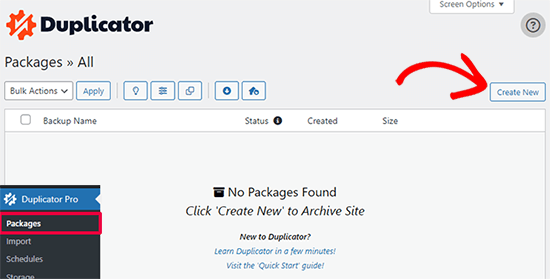
Duplicator inizializzerà ora la procedura guidata posteriore e assegnerà automaticamente un nome a questo pacchetto.
Fare clic sul pulsante “Avanti” per continuare.
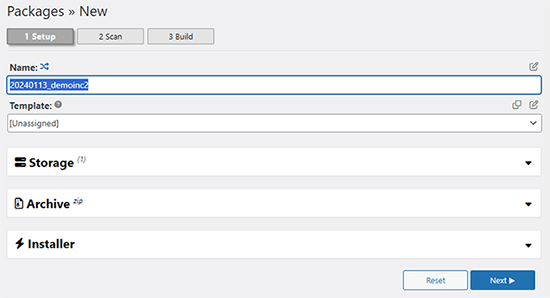
Duplicator eseguirà ora alcuni test per verificare se tutto è in ordine. Se il plugin trova un problema, verrà visualizzato un avviso con le istruzioni.
Se tutti gli elementi sono contrassegnati da “Buono”, fare clic sul pulsante “Costruisci”.
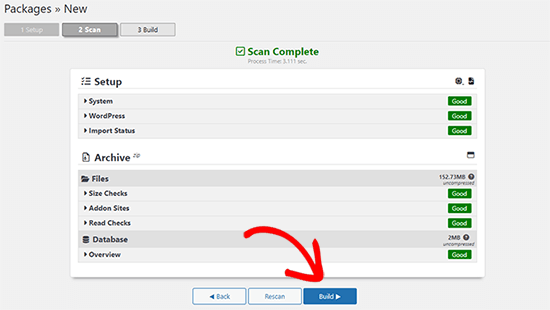
Il plugin inizierà a creare un pacchetto di duplicazione dei file del sito web. Questo processo può richiedere alcuni minuti, a seconda delle dimensioni del sito.
Una volta terminato, verrà visualizzata l’opzione “Download”. Facendo clic su di essa, si potrà scegliere di scaricare entrambi i file o di scaricare il programma di installazione e l’archivio (zip) separatamente.

Scegliere “Entrambi i file” per scaricarli sul computer.
Il file di archivio è una copia completa dei file di WordPress. Include i temi di WordPress, le impostazioni dei permalink, i plugin, i caricamenti e qualsiasi altro file creato dai plugin di WordPress.
Lo script di installazione è un file PHP che automatizza ed esegue la migrazione di WordPress scompattando il file di archivio.
Fase 2: Creare un database per il nuovo nome di dominio
Prima di spostare il vostro sito WordPress sul nuovo dominio, avrete bisogno di un nuovo database SQL per disimballare WordPress sul nuovo nome di dominio.
Se avete già creato un database, potete saltare questo passaggio.
Per creare un database, è necessario visitare la dashboard del cPanel del proprio account di hosting, scorrere verso il basso fino alla sezione “Database” e quindi fare clic sull’icona “Database MySQL”.
Vi mostreremo come individuarlo su Bluehost, ma le istruzioni di base sono le stesse e dovrebbero valere per tutti i provider di hosting.
Accedere al cruscotto del proprio account Bluehost e fare clic sul pulsante “Impostazioni” sotto il proprio sito web.
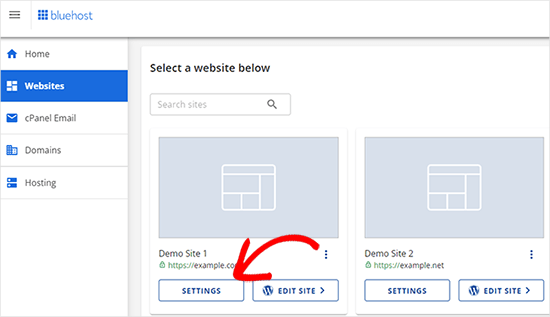
Nelle impostazioni del sito, è necessario passare alla scheda “Avanzate”.
Scorrete un po’ in basso fino alla sezione cPanel e fate clic su “Gestione”.
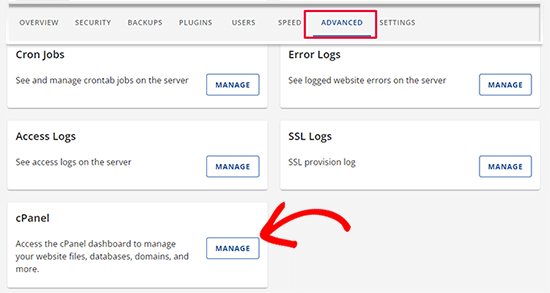
Si aprirà il cruscotto di cPanel.
Scorrete la sezione Database e fate clic sull’opzione “Database MySQL”.
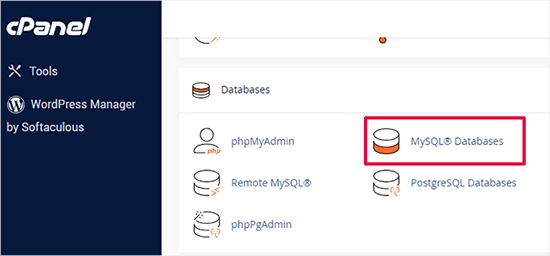
Nota: il pannello di controllo del vostro hosting potrebbe avere un aspetto leggermente diverso da quello delle schermate. Tuttavia, dovreste essere in grado di trovare una sezione Database con un’opzione per creare un nuovo database.
È sufficiente indicare un nome per il database e fare clic sul pulsante “Crea database”.
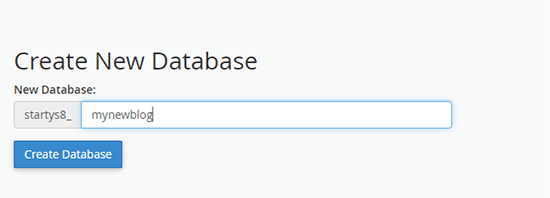
cPanel creerà un nuovo database per voi. Dopodiché, è necessario scorrere verso il basso fino alla sezione Utenti MySQL.
Quindi, fornire un nome utente e una password per il nuovo utente e fare clic sul pulsante “Crea utente”. Assicuratevi di annotare il nome utente e la password in un luogo sicuro.
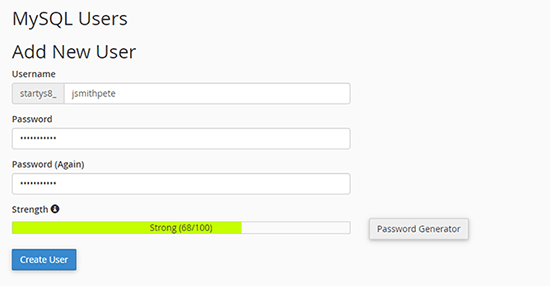
Il nuovo utente appena creato non ha ancora il permesso di lavorare sul database. Modifichiamo la situazione.
Scorrere fino alla sezione “Aggiungi utente al database”. Per prima cosa, selezionare l’utente del database creato dal menu a discesa accanto al campo “Utente”. Quindi selezionare il nuovo database appena creato e fare clic sul pulsante “Aggiungi”.
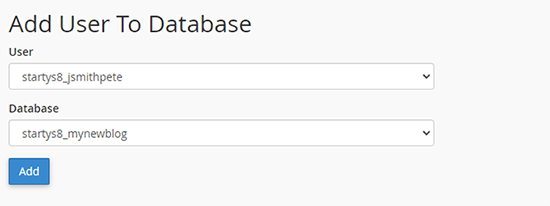
Successivamente, vi verrà chiesto di scegliere i privilegi per l’utente.
Selezionare “Tutti i privilegi” e fare clic sul pulsante “Apporta modifiche” per continuare.
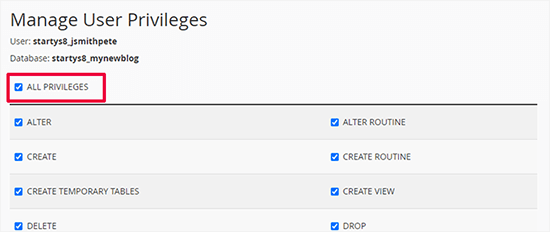
Il database è ora pronto e può essere utilizzato per spostare WordPress sul nuovo nome di dominio.
Assicuratevi di annotare il nome del database, il nome utente e la password. Queste informazioni vi serviranno nella fase successiva.
Fase 3: Disimballare WordPress sul nuovo nome di dominio
Ora è necessario caricare i file di Duplicator scaricati in precedenza sul nuovo nome di dominio.
Il pacchetto Duplicator include anche l’installazione di WordPress. Ciò significa che non è necessario installare WordPress sul nuovo dominio.
Per prima cosa, collegatevi al vostro nome di dominio utilizzando un client FTP. Una volta collegati, assicuratevi che la directory principale del vostro sito web sia completamente vuota.
Dopodiché, è possibile caricare i file dell’archivio e del programma di installazione nella directory principale. Questa è solitamente chiamata public_html.
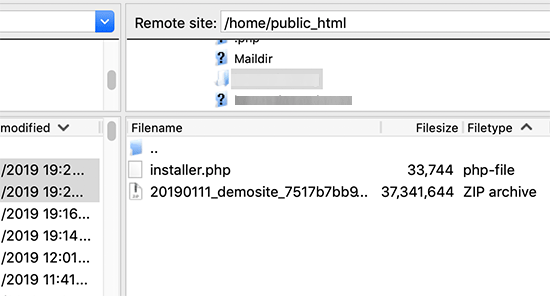
Una volta che entrambi i file hanno terminato il caricamento, siete pronti a scompattare WordPress.
Aprite una nuova scheda del browser e visitate il seguente URL:
http://example.com/installer.php
Non dimenticate di sostituire example.com con il nuovo nome di dominio. In questo modo si avvierà la migrazione guidata di Duplicator.
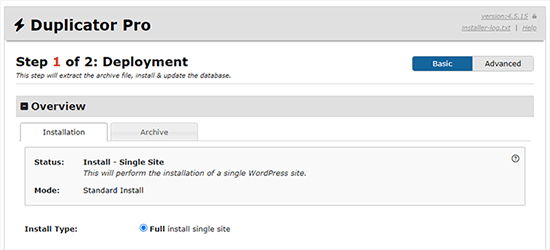
Il programma di installazione cercherà il file di archivio e selezionerà automaticamente le opzioni sullo schermo.
Scorrete un po’ in basso per inserire le informazioni relative al database creato nel passaggio precedente.
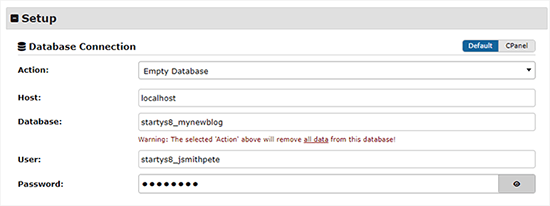
Di seguito, Duplicator mostrerà automaticamente l’URL del vecchio dominio e del nuovo dominio.
Se tutto sembra a posto, fare clic sul pulsante “Convalida” per continuare.
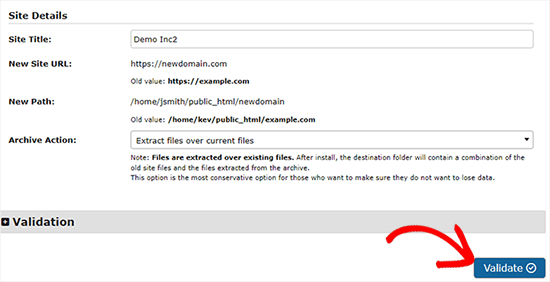
Duplicator tenterà ora di connettersi al database utilizzando le informazioni fornite.
In caso di successo, verrà visualizzato un Passaggio di convalida. In caso contrario, verrà visualizzato un avviso con i dettagli su come risolvere il problema.
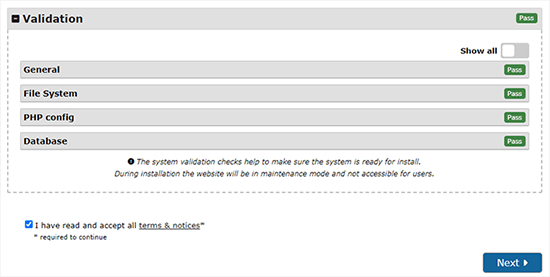
Fare clic sul pulsante “Avanti” per continuare.
Duplicator inizierà a importare il vostro sito web WordPress. Al termine, verrà visualizzato un messaggio di successo con un pulsante di accesso all’amministrazione.
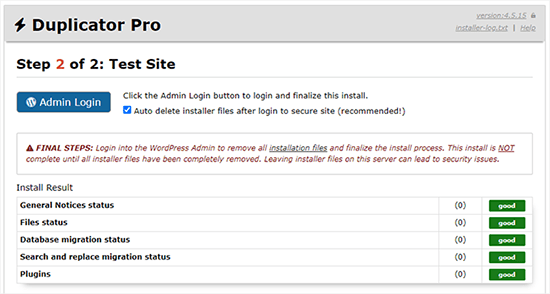
Duplicator aggiornerà automaticamente gli URL al nuovo nome di dominio. Ora è possibile fare clic sul pulsante “Accesso amministratore” per completare le fasi successive.
Passo 4: Impostare reindirizzamenti 301 permanenti
Il passo successivo è quello di indirizzare gli utenti che arrivano sul vecchio nome di dominio verso il nuovo dominio. A tal fine, è necessario impostare i reindirizzamenti 301.
I reindirizzamenti 301 sono molto importanti per la SEO e l’esperienza utente. La loro aggiunta consente di reindirizzare automaticamente gli utenti e i motori di ricerca verso il nuovo nome di dominio.
In altre parole, ogni volta che qualcuno approda a un post o a una pagina del vostro vecchio dominio, verrà automaticamente reindirizzato allo stesso post o alla stessa pagina del vostro nuovo dominio, invece di visualizzare un errore 404.
Per mantenere i reindirizzamenti, è necessario mantenere attiva la vecchia installazione di WordPress, in modo che possa continuare a reindirizzare alla nuova appena creata.
Esistono due modi per impostare i reindirizzamenti. Il primo metodo è semplice e richiede solo pochi clic. Il secondo metodo richiede la modifica manuale dei file.
Metodo 1: Impostare i reindirizzamenti 301 con All in One SEO
Per questo metodo, avrete bisogno di All in One SEO (AIOSEO). È il miglior plugin SEO per WordPress sul mercato e vi permette di ottimizzare facilmente il vostro sito web WordPress per la SEO.
Innanzitutto, è necessario installare e attivare il plugin All in One SEO sul vecchio dominio. Per maggiori dettagli, consultate la nostra guida passo passo su come installare un plugin di WordPress.
Nota: per accedere all’addon per la gestione dei redirect è necessaria almeno la versione Pro del plugin. Potete anche impostare AIOSEO sul vostro nuovo sito WordPress per incrementare ulteriormente il posizionamento sui motori di ricerca e il traffico.
Dopo l’attivazione sul vecchio dominio, è necessario visitare la pagina All in One SEO ” Reindirizzamenti e fare clic sul pulsante “Attiva reindirizzamenti”.
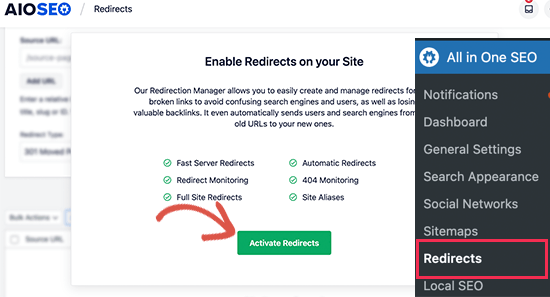
Successivamente, è necessario passare alla scheda “Reindirizzamento completo del sito” e attivare la levetta “Ricolloca sito”.
Dopodiché, è necessario inserire il nuovo nome di dominio accanto all’opzione “Trasferire su dominio”.
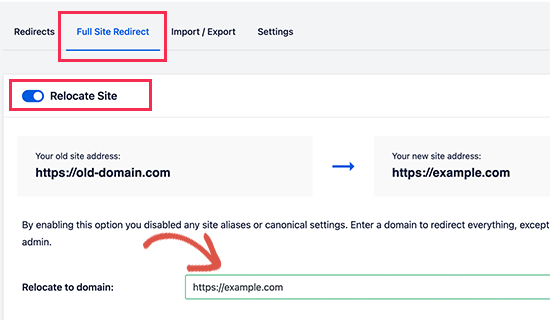
Non dimenticate di fare clic sul pulsante “Salva modifiche” per memorizzare le impostazioni.
Metodo 2: Impostare manualmente i reindirizzamenti al nuovo dominio
Questo metodo richiede la modifica del file .htaccess di WordPress sul vecchio nome di dominio.
Per prima cosa, è necessario collegarsi al vecchio sito tramite FTP e modificare il file .htaccess.
Questo file si trova nella stessa cartella di wp-includes o wp-admin. Aprite il file .htaccess e incollate le seguenti righe di codice all’inizio:
#Options +FollowSymLinks
RewriteEngine on
Unchanged: RewriteRule ^(.*)$ http://www.newsite.com/$1 [R=301,L]
Assicuratevi di sostituire newsite.com con il vostro nuovo dominio nel codice sopra riportato.
Una volta applicate queste modifiche, visitate il vostro vecchio nome di dominio. Dovrebbe reindirizzarvi automaticamente al nuovo dominio.
Se non lo fa, significa che il reindirizzamento non è impostato correttamente e che il vostro server probabilmente non supporta le regole di reindirizzamento. È necessario contattare il team di assistenza della società di web hosting per attivare RewriteEngine.
Passo 5: notificare a Google il nuovo dominio
Ora che avete spostato WordPress su un nuovo nome di dominio e avete impostato i reindirizzamenti, è il momento di notificare a Google il vostro cambio di indirizzo. In questo modo Google troverà rapidamente il dominio del vostro nuovo sito web e inizierà a mostrarlo nei risultati di ricerca.
Innanzitutto, è necessario assicurarsi che il nuovo e il vecchio dominio siano aggiunti a Google Search Console come due proprietà diverse. Per le istruzioni, consultare la fase 1 della nostra guida a Google Search Console.
Successivamente, è necessario selezionare il vecchio nome di dominio come proprietà attiva nella dashboard dell’account di Google Search Console.
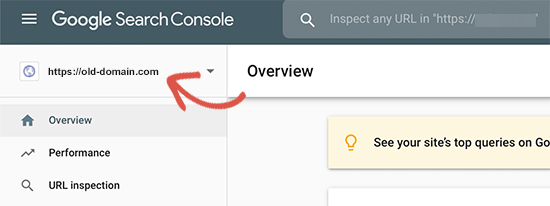
Successivamente, fare clic sul menu Impostazioni dalla colonna di sinistra.
A questo punto è possibile fare clic sullo strumento “Cambiamento di indirizzo”.
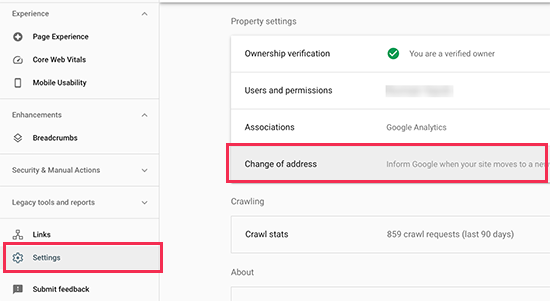
A questo punto, è necessario selezionare il nuovo dominio dalla sezione Aggiorna Google.
Quindi, si deve fare clic sul pulsante “Convalida e aggiorna”.
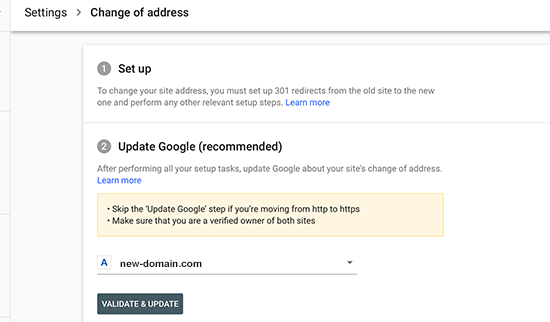
Questo è tutto. Google convaliderà ora che il vecchio dominio sta reindirizzando al nuovo dominio e salverà le modifiche.
Nella schermata successiva, Google Search Console vi mostrerà una procedura guidata passo dopo passo per inviare la richiesta di cambio di indirizzo.
Notificare agli utenti il nuovo nome di dominio
Mentre i reindirizzamenti 301 fanno il loro lavoro, è sempre bene fare un annuncio pubblico della migrazione.
Per farlo, è sufficiente scrivere un post sul nuovo sito e condividerlo sui propri account di social media.
Se avete una newsletter via e-mail o abbonati alle notifiche push, dovreste inviare un annuncio anche a loro.
Questo può essere utile in molti modi.
In primo luogo, è più probabile che i vostri utenti si ricordino del nuovo dominio una volta che lo hanno letto.
In secondo luogo, potete chiedere ai vostri utenti di farvi sapere se notano qualche bug. Da soli non potete testare il vostro sito con ogni tipo di browser o ambiente di sistema. È sempre utile avere un paio di occhi nuovi che lo guardino.
Speriamo che questo tutorial vi abbia aiutato a spostare il vostro sito WordPress su un nuovo nome di dominio. Potreste anche consultare la nostra guida su come ottenere un dominio e-mail gratuito o la nostra scelta dei migliori servizi telefonici aziendali.
Se questo articolo vi è piaciuto, iscrivetevi al nostro canale YouTube per le esercitazioni video su WordPress. Potete trovarci anche su Twitter e Facebook.




Syed Balkhi says
Hey WPBeginner readers,
Did you know you can win exciting prizes by commenting on WPBeginner?
Every month, our top blog commenters will win HUGE rewards, including premium WordPress plugin licenses and cash prizes.
You can get more details about the contest from here.
Start sharing your thoughts below to stand a chance to win!
Moinuddin Waheed says
When we migrate our blog to the new domain name and all the files and database gets into its new domain , how long does it take for Google to know that it has to rank this new domain?
Also old domain names have domain authority and new domain names will take time to build a domain authority, how does seo remain unaffected if we switch to new domain?
WPBeginner Support says
The 301 redirects are what tell Google to take note of the new domain. There is no specific timeline for when Google will update but as Google crawls the 301 redirects it will redirect and update your listing in search results. While your old links rank they will also redirect to the new location.
Admin
Moinuddin Waheed says
Thanks for the reply and clarification about the query.
I think after some time of the full setup to the new domain, isn’t it prudent to completely close the old domain and focus on new domain.
or is it better to let 301 redirect continuously redirects to the posts and page and in the meantime when we fully satisfy that all old domain requests are redirects to new one, only then we take decision to stop old domain.
WPBeginner Support says
You would want to check the analytics for the old domain, if you are still getting a good amount of traffic to that domain that is being redirected then you would keep the old domain active, if you are not getting visits to your old domain you would then look to close it.
WPBeginner Support says
If you reach out to your host they can sometimes help and temporarily override their upload limits to get your files into your hosting.
Admin
Jackie says
What if my file size to be uploaded is over the max 500MB, and I am using Bluehost to upload the files?
Moinuddin Waheed says
for redirecting to new domain, it is better to use the plugin itself that you have suggested i.e all in one seo which is easy to do for all with no coding knowledge people.
And as for accessing the .htaccess file and manually changing it to redirect is somewhat only technical expertise people will look forward to.
Don says
Hi, thank you so much for your guide. We our doing a rebranding resulting in a name change and new url. Our WP administrator will be doing the migration and 301 redirect. Aside from notifying our database and social media followers in our newsletter, I am wondering if we can create a landing page on the new site for the redirects that announces the rebranding, and then segues into the new site after a preset interval.
WPBeginner Support says
If you wanted to instead of redirect 1 to 1 the articles, you could certainly redirect the entire site to a landing page.
Admin
Unarine Leo Netshifhefhe says
My website has been hacked and I haven’t really gotten time to fix it that much, I would like to know if this problem of it been hacked has some kind of effect on SEO? Does it affect it badly? And my website stops appearing?
WPBeginner Support says
It would depend on if anything changed on the front-end of your site but it can have a negative effect on your site’s SEO.
Admin
Simon says
How do I use FTP client to connect my domain?
WPBeginner Support says
You would not use FTP for your domain, you would want to use the tools in either your domain registrar or hosting provider.
Admin
Manu Philip says
Thank you ! It helped a lot
WPBeginner Support says
Glad our guide was helpful!
Admin
Saifullah Tamim says
Many Many thanks brother. This article is very helpful.
WPBeginner Support says
Glad our guide was helpful!
Admin
Sajid says
for how many days I need to keep the old site running. For 301 redirection
WPBeginner Support says
There is no universal answer for every site, it would depend on your site and audience but if you wanted to be safe a year is normally long enough for users who would revisit your site to see the change especially if they check your site for seasonal content.
Admin
James says
Hello, I hope you are doing good. How about migrating a subdomain to a completely new domain name ? For example, migrating “example.blog.com” to “example.com”.
WPBeginner Support says
You can still use this method for moving from a subdomain to a completely new domain
Admin
ronald says
we still are using our existing site for some things, but not for blogs. these were migrated. we set up 301 redirects and all working smoothly but curious… after migration, with 301 redirects all set up on old server, should we unpublish the posts on old server so they no longer are on old sitemap?
WPBeginner Support says
If you plan to continue to use your old site for other uses then it would normally be best to remove the content you’ve set up redirects for.
Admin
thierry says
Thanks a lot for this piece, following thes instructions was really clear and everything went smooth without any problems thanks thanks and thanks!
WPBeginner Support says
Glad our guide was helpful!
Admin
Mark says
Thank you. I tried so many other plugins and techniques – none worked very well.
Although crazy complex for a simple thing this is a great technique. After nuking my earlier attempts this one fixed everything. Fonts, images, thumbnails, etc.
Thank you.
WPBeginner Support says
Glad our guide could help simplify the process in a way that worked for you
Admin
Manas Patil says
Hello, this article was of great help. Thanks a ton!
But I’d to ask – since I’ve one SSL certificate, I thought I’d move the SSL from my old site to my new site. If I do move it, should it cause any errors while I redirect from my old site to new site?
Thanks in advance!
Manas
WPBeginner Support says
You would want to check with your hosting provider as some have methods to help prevent any errors when changing domains on the same host if they only have one SSL certificate. In general, it should not cause any issues if set up properly.
Admin
Manas Patil says
Thanks a ton! I managed to move my site completely. Towards the end of the Search Console part, is it necessary to submit the sitemap again – because I don’t see my previous sitemap submissions on my new domain property.
WPBeginner Support says
If you haven’t submitted a sitemap for the new domain you would want to do so to help Google crawl your URLs
BIKRAMJIT KONWAR says
Hi, many thanks for the article. I have a confusion here, can I migrate my WordPress site to a new domain without migrating the existing theme as I want to change the theme?
Amir says
Hello
After migration to new domain, how should i send new post on my site ? Send a new post on old domain or new domain?
Md Shuaib Raza says
Can i delete and cancle my old domain name by provoider after migration?
Paco says
I’m moving to a new domain name, but I’m still going to use the old domain name for other purposes. I don’t want to redirect the entire oldsite to newsite. What’s the recommended way in this case? Thanks.
Hassan says
It helped me a lot, my question is in ftp I will enter my new domain name and user name and password, then you said the installer file and archive file the installer file is it the wordpress zipp file or something else?
WPBeginner Support says
The installer file would be what you downloaded from the Duplicator plugin.
Admin
F NIc says
Hi, thank you for this detailed guide. I intend to switch domain from Bluehost to GoDaddy and I am wondering if my wordpress website will be affected in terms of how it will look after the switch.
WPBeginner Support says
Your hosting provider would not affect how your site looks, as long as there are no issues with the duplication process the site should look the same.
Admin
Sachin says
I have a question, I have single web hosting, so how can I move from the old domain to the new domain?
WPBeginner Support says
If you are staying on the same host, you would first want to check with your hosting provider as some have tools to help with changing your site’s domain.
Admin
Andy says
I’m having a little trouble with Step 5. Notifying Google About the Change.
When I filed the change of address (the Search Console seems to have changed since you wrote this post, but I figured out the new procedure OK), the validation failed because Google couldn’t fetch the home page for my old site.
WPBeginner Support says
Thank you for letting us know, for this situation, you would want to point Google to your new site for it to test the redirects.
Admin
Sharon says
Thank you so much for this tutorial it was so easy for me to redirect my old domain
WPBeginner Support says
Glad our guide was helpful
Admin
amir says
can I delete the old host and domain after I did all the steps? or I should renew the host and domain after then
Thanks
WPBeginner Support says
It is normally a good idea to redirect the old domain to the new one for some time but you can end the old hosting and still redirect the old domain if you wanted.
Admin
Dejan says
Hi Wpbeginner!
Very good article as usual, i have a question just to double check, will all paths be changed? For example media links and so on? Thanks again
WPBeginner Support says
Using this method, your links to images and other media should be updated as well.
Admin
dariu says
Thanks for this. What is the difference for migrating to new host (and domain)? Is there any difference in steps and instructions?
WPBeginner Support says
You would use the same steps for a new host as well.
Admin
Penny says
I had to put in mine in the public_html folder to work. Very frustrating at first until I tried that!
Jose says
Thanks for a great tutorial!
I’ve ran into a quirk after following all the steps.
My site redirects everything EXCEPT the content of the home page.
I updated the name servers about two days ago.
I did the redirection via .htaccess.
I’m not sure where to look to troubleshoot the issue. Any direction is appreciated. Thanks again!
WPBeginner Support says
We would recommend checking for any caching plugins as well as reaching out to your hosting provider for the most common reasons for that issue and your hosting provider can normally take a look from their end as well.
Admin
Jose says
Following up.
I was/am using W3 Total Cache.
Before I migrated, I forgot to disable caching. And that caused issues.
After the migration, I had to manually remove W3 Total Cache in order to get the new site working again.
There was a section of caching code left over in the new .htaccess file.
All has been good since then!
WPBeginner Support says
Glad you were able to get the issue sorted
Haitham says
Hi,
Great tutorial. I have to ask about the SSL redirects since it may cause issues for domains that use cloudflare for instant.
So while adding the code on the .htaccess file in the old website how do I add a newwebsite.com/1$ to that command ?
WPBeginner Support says
If you mean how to update your site to a new domain using a CDN like Cloudflare, we would recommend reaching out to the CDN you are using for their current methods for that kind of change.
Admin
Joe says
In the last step you mentioned “notify google about the change”.
But what if don’t notify Google about the change, just move the website to new domain, and remove all the pages from old domain (as my website is new and doesn’t have any organic traffic)?
Is it valid?
WPBeginner Support says
You can do that if you want but you would likely take a negative hit in your search engine rankings.
Admin
Jay Dee says
I have a question about subscribers the website who have created profiles. Would I have to do redirects for their individual profile pages ?
WPBeginner Support says
If you are using the same systems then you shouldn’t need an additional redirect unless the tool you are using says so.
Admin
Rajesh says
I have a question, I already set 301 redirection, and all the request to the old site is redirecting, now my question is, when I can delete old site and its content permanenty?
WPBeginner Support says
After you create your redirects you can remove the old content.
Admin
Morgan says
Hello, please I’m confused on this sentence “Once connected, make sure that the root directory of your website is completely empty.”
How can make the root directory to be empty cause is showing some files and folders. Please I need an answer on how to do that. Thanks
WPBeginner Support says
You can either use FTP or some hosts have file managers you can use to delete the folders or you can reach out to your host for assistance
Admin
Braeden says
Thanks for this! How would you handle domain1 is moving to domain2, but, many of the URL slugs on domain1 are different on domain2. For example, domain1/this-is-a-post/ will be going to domain2/this-is-the-new-post/
WPBeginner Support says
It would depend on the specific changes but depending on how drastic the change you may need to manually set up the individual redirects.
Admin
Marco says
Thank you for this guide. It helped me.
I tried the 301 redirect on htaccess. However it only redirects the homepage. Any chance for help? Thanks
WPBeginner Support says
You may want to try clearing your caching and checking with your hosting provider to ensure they don’t see any errors on their end.
Admin
Gosia says
This is great if moving a complete old site to a new domain. But what to do to when you are setting up a new site and want to move over only a few posts from the first site? I don’t want to lose organic traffic.
WPBeginner Support says
You can check under Tools>Export and select the specific posts you want to transfer to your site.
Admin
Alexandre says
Thanks a lot for this tuto.
I don’t understand why we have to set up permanent 301 redirects if I keep the same domain name ?
Thank for your answer,
Alex
WPBeginner Support says
This article is for moving a site to a new domain name. If you only want to change hosting providers, you would want to take a look at our article below:
https://www.wpbeginner.com/wp-tutorials/how-to-move-wordpress-to-a-new-host-or-server-with-no-downtime/
Admin
Alexandre says
Sorry, thanks a lot.
You blog posts have always helped me a lot
WPBeginner Support says
Glad our guides have been helpful
Prasad Rane says
Hey thanks a lot for this step by step tutorial.I was able to move clients site in just 30 mins. He was surprised. Thanks a lot.
WPBeginner Support says
Glad our guide could help
Admin
Luiz Pedao says
Hello, got a bit of a problem here. I transferred my good php and zip files to the public directory, and yet when I browse to mydomain/installer.php it just doesn’t find the page. What could be the problem?
Thanks in advance
WPBeginner Support says
You may want to reach out to your hosting provider to ensure the domain is set up to the correct location that you’re adding the files.
Admin
Razi says
Thanks, Buddy, After reading your article It’s just like the peace of cake
WPBeginner Support says
Glad our article could be helpful
Admin
hassan says
GOOD guide.
but if I want to change my URLs in a new domain
my post in the old domain is: oldedoman.com/best-products-2020/
I want to change to newdomain.com/best-products/
How to redirect all my posts
Thanks
WPBeginner Support says
For that type of change, you would need to create manual redirects following our guide below:
https://www.wpbeginner.com/beginners-guide/beginners-guide-to-creating-redirects-in-wordpress
Admin
Adrian Filip says
Brilliant tutorial. Thank you! Work like a charm!
WPBeginner Support says
Glad you found our guide helpful
Admin
Megan says
Does this process work with a bluehost basic account? I have purchased my new domain but can’t assign it as an Addon domain since I can only have 1 website. What is the best way to work with this?
WPBeginner Support says
If you’re unable to create an addon domain we would recommend reaching out to your host and some offer support or different ways to set it up.
Admin
Megan says
Does this method work if I am using the Bluehost Basic plan where I can only have one website? I can’t make my new domain an add on domain.
WPBeginner Support says
You can move from a host to BlueHost’s basic plan following this guide
Admin
Utsav says
Hi,
I have questions that where to use 301 redirect, in new domain .htaccess or old domain .htaccess.
In my case I have changed my website domain as well as web hosting. Then where to apply 301 redirect and how many time I should active my old domain and hosting active?
WPBeginner Support says
You would want to add 301 redirects to the old domain. It depends on your old site and personal preference for how long you should keep the old domain active but you shouldn’t need the old hosting.
Admin
Suchitha says
I earlier had my domain in a WordPress site that I do not own. I developed my website there. Now, I have moved my domain to a new WordPress site that I own and also used the Export/Import option to transfer my content to the new site. However, I am having to re-design my website again. Does the procedure mentioned here ensure that my site is transferred intact?
WPBeginner Support says
The method in this guide should let you keep your theme and plugins how they are set up.
Admin
Adz says
Hi, thanks for sharing.
Once I’ve successfully migrated my old website to the new domain, will the 301 redirect continue to redirect even after ive deleted my old website? The reason I’m asking is because I have several posts on facebook that point to my old site.
WPBeginner Support says
As long as the redirect remains in your htaccess file it will continue to redirect to your site.
Admin
Ejimurphy says
After moving the the old site to new site, do I still need to purchase new SSL certificate or the SSL certificate for old site will work for the new site
Thanks!
WPBeginner Support says
Most hosts should offer Let’s Encrypt as a free option but you would need to set up SSL for your new domain.
Admin
Mark says
Perfect! Thank you for a great post!
WPBeginner Support says
You’re welcome
Admin